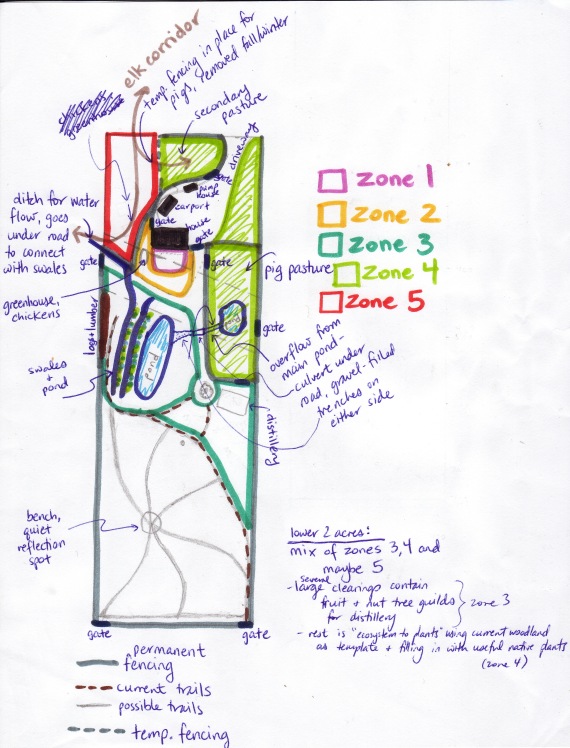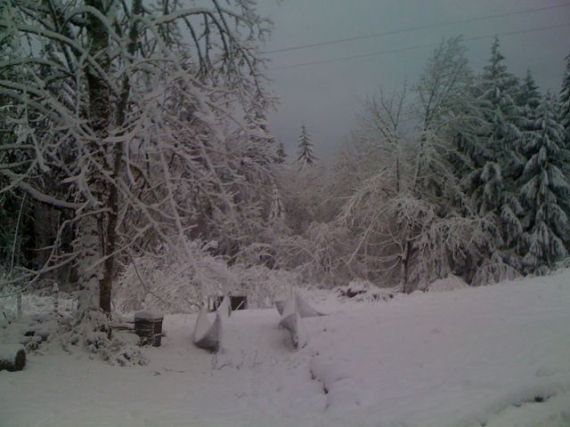I’ve been very busy these past few weeks: on any given sunny day, and on several slightly rainy ones, I could be found outside with my 100 ft tape measure, a stake and a mallet, and a sheaf of paper (sometimes wrapped in a clear plastic bag). I was using triangulation to create an accurate map of our property and the major features on it: driveway, house, shed, etc. It took me a few days to get all the measurements, and parts were tricky. In order to use triangulation to locate a specific object in space you must start with two known points that, together with the object, form a triangle. Our property is large and does not contain many two-point features, so often I had to work my way out to a desired object, by locating two trees I could use, or even by planting stakes in the ground.
The result of all this hard work (and a bit of fun with a compass and square-ruler that took me back to grade-school geometry class) was this:
This shows the complete North boundary (North is Up), and the east and west boundaries. The southern boundary is not shown, as it lies way down the page. What you see is approximately half the true length of our property. The Northern boundary lies some distance from our street, which runs west to east, ending at a dead end about halfway along the length of our northern boundary. East from there one enters the forest through a hiking trail. So while it looks as though the house is practically on the street edge, in fact we have a fair amount of yard that extends northwards past the true property boundary to the street.
The dotted lines show the Right of Way (ROW) for the local utility company. A pair of residential power lines runs through this corridor (the poles are not on our property) and there are restrictions on building within this area.
Our driveway begins in the northeast corner and wraps around the house so that the area marked by solid lines including the house, garage, and shed is all gravel save for the tear-drop shaped garden area in front of the deck. This area, enclosed by the solid lines, is flat, having been dug into a hillside. Thus the shaded area behind the garage and part of the house, which is a steep grade of earth that rises abruptly to the high point on our property – the northwest corner. Standing at the northwest corner of the garage the earth rises about 8 feet almost straight up, but quickly comes down as one walks southwards, so that at the site of the shed the land is only a couple of feet higher than the grade around the buildings.
The roadway that extends downwards from the main living area is, as of right now, dirt and rather loosely defined. It wanders southwards until, within the ROW it turns to the west and leads out of the property through a gate, and into the forest next door.
Using this map I was able to play with siting our future cob house. I cut out a square whose dimensions corresponded to 33 x 60 ‘ (2000 sq ft) and moved it around to see where it would fit. I wanted the parking area to be north of the house so that the southern views were not marred by cars, which also renders the south yard area quite unusable. I wanted to avoid doing any more grading and earth moving if possible (I hate the fact that they dug into the hillside in the first place: it looks like a wound on the earth having that great wall of earth rising up behind the buildings). And we could not have the building anywhere within the ROW. Since there is a neighbour to the east with a house close to the property boundary we wanted to avoid building along the east side. I eventually settled on a site for the future house, though mostly for the purposes of moving forward with the design process: I’m not certain this is where it will end up, but it gave us a starting place.
It then took some time and many false starts to finally come up with a plan for how to divide up the property into the various Zones of permaculture.
This map is almost the entire property; it should actually extend a bit further down but I decided not to be accurate there for the sake of having a manageable paper size. The living area shows the future house (largest black rectangle). Zone 1 is outlined in pink and will contain the kitchen garden, patio and other outdoor living areas. Zone 2 is outlined in yellow and will include more kitchen garden plants, including some dwarf fruit trees and berries, a greenhouse, chicken coop, greywater ponds, rainwater harvesting barrels and cisterns.
Zone 3 will contain most of our polyculture guilds: fruit and nut trees around which guilds are built. These will form our Food Forest. It also contains a spot for drying out logs and milled lumber (brown area on west side). Finally, this Zone contains our water harvesting system, which I’ll now describe in detail.
When it rains, a small stream forms that runs into our property through the West Gate. This is water that comes out of the forest and collects along the power line roadway (which forms a natural ditch that directs water onto our site). A substantial amount of water flows through here during the wet season and we wish to capture and store it and use it to our advantage. So the dark blue line starting at the West gate shows my idea for digging a proper ditch that would then have to run under the road (a simple culvert would do) to get to our Zone 3. This ditch would feed into a system of swales – ditches that run on contour, on the downward side of which are mounds of earth (berms) that are planted with polyculture guilds. The swales capture the water, spread it out over a long stretch, where it slowly sinks into the berms and irrigates the plantings on the berms. Each swale has an overflow area that feeds into the swale below. I’ve only drawn two swales here but probably we have room for 3 or more (this area slopes rather steeply to where I’ve drawn the larger pond). The final swale feeds into the pond. Right now this area is a seasonal “giant puddle” that is overgrown with salmonberry bushes. We’d like to dig it deeper and turn it into a true pond, create a wetland garden around it, and figure out how to make it less permeable so it holds the water year-round. This area will then be home to some geese and ducks, who will do double-duty providing eggs and meat as well as patrolling the food forest for slugs. There will be an overflow for the large pond – a gravel-filled trench, that will lead eastwards under the roadway (culvert) to a smaller, secondary pond. This is currently another seasonal “large puddle” where salmonberries abound. We may try to fix it so it is still wet when the pigs are here, providing them with a place to cool off. But the main source of water for the pigs will be a rainwater harvesting system on the distillery building.
The “roundabout”-looking thing in Zone 3 is a large bigleaf maple tree that sits atop a hill, near the centre. We plan to extend the dirt road and make it go around the tree. From this point southwards the property is all woodland. The brown dotted lines are current trails through the forest. The future Distillery building will go east of the maple tree; an area will be cleared to the south of the building to allow solar access, and within that part of Zone 3 will be more fruit and nut guilds with which my husband hopes to create some interesting spirits.
The light green areas are Zone 4, which can be divided into 3 sections. The first lies along the east side of the driveway and is currently full of trees and shrubs. We’re going to leave this as is for now, as it provides a nice privacy screen to the neighbour’s house. South of that area is a roughly 1/4 acre pasture which will house our pigs each spring/summer. We’re hoping there is enough land in there for them to graze without completely digging up the place, but if necessary we can divide it up into 2 or 3 sections and rotate them through it. The third section of Zone 4 is north of the house. This will be a reserve grazing area for the pigs should the other pasture not be sufficient in size to prevent them overgrazing it.
The grey lines show where we plan to install permanent fencing. The entire area from the house to at least the southern edge of Zone 3 will be perimeter fenced so that deer and elk cannot get into the food forests (I’ve shown it extending around the entire southern half of our property, but am no longer sure if we need to do that). However, I wanted to include in our plans a way for the local elk herd to continue visiting our property. It has been such a wonderful and meaningful experience to wake up to the sight of these gorgeous animals grazing so close to our house, and I wanted to include them in our design plan. So you’ll note that, in the northern section of Zone 4, the permanent fencing ends about halfway along the northern boundary as you approach from east to west. This is so we can leave it open when not in use by the pigs. The elk have been accessing the property through the northwest corner (which is forested) and grazing along the western strip of pasture, then leaving through the West Gate. So by leaving that part unfenced we retain their access. The bit of permanent fencing can easily be closed off by running a short length of temporary fencing (dotted grey lines) for when the pigs need to use it. Removing the temporary fence will open up that part to the elk when the pigs are not using it. Thus, the area in red denotes Zone 5: the wild, untouched zone.
This leaves the bottom 2 acres below Zone 3 to design. I scribbled some notes in there, but have since changed my mind. In wandering through the woodland this winter I’ve fallen in love with it again and am increasingly distressed at the thought of disturbing it much further. I’m hoping that the area already set aside for Zone 3 will provide enough fruit and nut trees to keep my husband happy. Then I could leave the rest as is, though I have some ideas to experiment with what is called “ecosystem to plants” design, basically starting with the current woodland as a template and adding or replacing certain other plants to increase ecosystem health, restore at-risk native species, or just experiment with new polyculture blends. I’ll talk more of this in a future post about my upcoming farm project, which involves this area. For now, I’m hoping to leave this area “as is” and see what we can do with it while preserving its unique beauty.
Well, if you’ve followed me thus far I hope I’ve kept you interested. The process of permaculture design is fascinating to me and I’ve really enjoyed the process so far.








